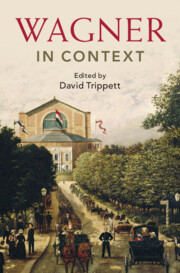Book contents
- Wagner in Context
- Composers in Context
- Wagner in Context
- Copyright page
- Contents
- Illustrations
- Musical Examples
- Contributors
- Acknowledgements
- Abbreviations
- Introduction
- I Place
- II People
- III Politics, Ideas, and Bodies
- IV Life, Language, and the Ancient World
- V Music and Performance
- VI Reception
- Chapter 35 Regietheater in Performance
- Chapter 36 Twentieth-Century Reception and Anti-Semitism
- Chapter 37 Bayreuth as Idea: Chamberlain, Wolzogen, Hitler
- Chapter 38 Performing Wagner in Israel: An Affront or a Tribute?
- Chapter 39 Nineteenth-Century Music Criticism
- Chapter 40 Wotan’s Stormtroopers and the Total Art Machine: Kittler’s Ring of the Nibelung
- Chapter 41 Sound Recording
- Chapter 42 The Wagnerian Erotics of Video Game Music
- Further Reading
- Select Bibliography
- Index
Chapter 36 - Twentieth-Century Reception and Anti-Semitism
from VI - Reception
Published online by Cambridge University Press: 14 March 2024
- Wagner in Context
- Composers in Context
- Wagner in Context
- Copyright page
- Contents
- Illustrations
- Musical Examples
- Contributors
- Acknowledgements
- Abbreviations
- Introduction
- I Place
- II People
- III Politics, Ideas, and Bodies
- IV Life, Language, and the Ancient World
- V Music and Performance
- VI Reception
- Chapter 35 Regietheater in Performance
- Chapter 36 Twentieth-Century Reception and Anti-Semitism
- Chapter 37 Bayreuth as Idea: Chamberlain, Wolzogen, Hitler
- Chapter 38 Performing Wagner in Israel: An Affront or a Tribute?
- Chapter 39 Nineteenth-Century Music Criticism
- Chapter 40 Wotan’s Stormtroopers and the Total Art Machine: Kittler’s Ring of the Nibelung
- Chapter 41 Sound Recording
- Chapter 42 The Wagnerian Erotics of Video Game Music
- Further Reading
- Select Bibliography
- Index
Summary
Today’s reception of Wagner and assumptions about the composer’s complicity in inspiring the Holocaust are primarily influenced by events that transpired long after the composer’s death. This chapter analyses Wagner’s own shifting attitudes toward Jews in the context of his life and times and considers the twentieth-century events that have shaped the Wagner legacy: Adolf Hitler’s associations with the Wagner family and Bayreuth, the exploitation of works and musical excerpts for political purposes during the Third Reich, rumours about the use of Wagner’s music in concentration camps, repertoire and staging during the Hitler years, and the troubled and conflicted reception of Wagner’s works in Israel. It also considers how refugees from Nazi Germany initially raised suspicion about the anti-Semitic content of the music dramas and their characters, how post-war scholarship has concentrated on proving these allegations, and how the Wagner family still struggles to come to terms with the past.
Keywords
- Type
- Chapter
- Information
- Wagner in Context , pp. 364 - 372Publisher: Cambridge University PressPrint publication year: 2024

